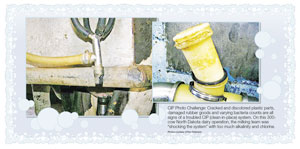Anyone remember the old Dunkin’ Donut commercials, “Time to make doughnuts”? The commercial dramatized the constant attention and long hours required to bake fresh doughnuts every morning. We received a call from a dairy producer in North Dakota that felt the same way about changing his inflations as the doughnut guy did about making doughnuts. “Time to change the inflations.” It was to the point that the producer was spending way too much time and money maintaining his milking equipment.
Our inspection
Upon arrival, we evaluated the operation’s equipment condition, water quality, CIP performance and milking procedures. Milking 300 cows three times a day, we discovered that the producer was challenged with not having enough time to wash in between milkings. Sadly, the milking team skipped a few washes and tried to make up for it by “shocking” the system and exceeding alkaline and chlorine recommendations. This treatment unnecessarily increased chemical use and costs, damaged rubber goods, broke down plastic parts – and wasted money. The producer also experienced varying bacteria counts, jeopardizing milk quality and premium payments.
Don’t shock the system
Shocking the system is never recommended. Any time a pipeline wash solution exceeds the recommendations for alkalinity and chlorine, a producer is shocking the system. This treatment shortens equipment life, increases ground water contamination, endangers safety and wastes money. Plus, it doesn’t correct the source of the problem.
Along with damaged inflations, we saw wear-and-tear problems with the North Dakota producer’s rubber gaskets, O-rings and hoses. We also documented premature cracking, discoloration and damaged interior surfaces to various plastic parts, including claws, meters, elbows, tees, milk hoses and milk wash plugs. While all these parts play a crucial role, damage to an inflation can be most costly. As an inflation wears out, somatic cell counts typically rise as teat ends are damaged, and cows milk out slower.
Simplified process
After identifying the problem and discussing the assessment with the producer, we determined that a single-cycle cleaner, free of alkaline and chlorine, would be a good fit for his operation. The shortened cleaning cycle immediately saved the producer water, energy and 23 percent off his previous chemical costs. Plus, it also reduced downtime in the parlor, which allowed this operation to run 43 more cows through the parlor.
In addition, cow milkability improved, bacteria counts dropped and production went up 5 pounds. The producer also saw better overall udder health and comfort.
“The changes happened practically overnight,” the producer told us.
Following recommended cleaning guidelines not only helped maximize milk production and attain higher milk quality premiums for this producer, it also will prolong the life of his plastic and rubber goods. He now will have more time – and money – to go do something else, like make some doughnuts. Dramatic positive results for this CIP investigation! PD
Click the image at left to open in a new window.

-
Ron Robinson
- VP Business Development
- A&L Laboratories
- Email Ron Robinson






